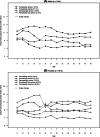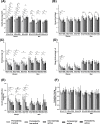Life-course leisure-time physical activity trajectories in relation to health-related behaviors in adulthood: the Cardiovascular Risk in Young Finns study
- PMID: 33740917
- PMCID: PMC7977567
- DOI: 10.1186/s12889-021-10554-w
Life-course leisure-time physical activity trajectories in relation to health-related behaviors in adulthood: the Cardiovascular Risk in Young Finns study
Abstract
Background: Evidence on whether leisure-time physical activity (LTPA) facilitates individuals' adoption of multiple healthy behaviors remains scarce. This study investigated the associations of diverse longitudinal LTPA trajectories from childhood to adulthood with diet, screen time, smoking, binge drinking, sleep difficulties, and sleep duration in adulthood.
Methods: Data were drawn from the Cardiovascular Risk in Young Finns Study. Participants were aged 9-18 years (N = 3553; 51% females) in 1980 and 33-49 years at the latest follow-up in 2011. The LTPA trajectories were identified using a latent profile analysis. Differences in self-reported health-related behaviors across the LTPA trajectories were studied separately for women and men by using the Bolck-Croon-Hagenaars approach. Models were adjusted for age, body mass index, education level, marital status, total energy intake and previous corresponding behaviors.
Results: Persistently active, persistently low-active, decreasingly and increasingly active trajectories were identified in both genders and an additional inactive trajectory for women. After adjusting the models with the above-mentioned covariates, the inactive women had an unhealthier diet than the women in the other trajectories (p < 0.01; effect size (ES) > 0.50). The low-active men followed an unhealthier diet than the persistently and increasingly active men (p < 0.01; ES > 0.50). Compared to their inactive and low-active peers, smoking frequency was lower in the increasingly active women and men (p < 0.01; ES > 0.20) and persistently active men (p < 0.05; ES > 0.20). The increasingly active men reported lower screen time than the low-active (p < 0.001; ES > 0.50) and persistently active (p < 0.05; ES > 0.20) men. The increasingly and persistently active women reported fewer sleep difficulties than the inactive (p < 0.001; ES > 0.80) and low-active (p < 0.05; ES > 0.50 and > 0.80, respectively) women. Sleep duration and binge drinking were not associated with the LTPA trajectories in either gender, nor were sleep difficulties in men and screen time in women.
Conclusions: Not only persistently higher LTPA but also an increasing tendency to engage in LTPA after childhood/adolescence were associated with healthier diet and lower smoking frequency in both genders, having less sleep difficulties in women and lower screen time in increasingly active men. Inactivity and low activity were associated with the accumulation of several unhealthy behaviors in adulthood. Associations were stronger in women.
Keywords: Alcohol; Binge drinking; Diet; Life-course; Longitudinal; Physical activity; Screen time; Sleep; Smoking; Trajectory.
Conflict of interest statement
The authors declare no competing interests.
Figures


Similar articles
-
Associations of Leisure-Time Physical Activity Trajectories with Fruit and Vegetable Consumption from Childhood to Adulthood: The Cardiovascular Risk in Young Finns Study.Int J Environ Res Public Health. 2019 Nov 12;16(22):4437. doi: 10.3390/ijerph16224437. Int J Environ Res Public Health. 2019. PMID: 31726760 Free PMC article.
-
Associations Between Trajectories of Leisure-Time Physical Activity and Television Viewing Time Across Adulthood: The Cardiovascular Risk in Young Finns Study.J Phys Act Health. 2019 Dec 1;16(12):1078-1084. doi: 10.1123/jpah.2018-0650. Epub 2019 Oct 10. J Phys Act Health. 2019. PMID: 31600733
-
Longitudinal physical activity trajectories from childhood to adulthood and their determinants: The Young Finns Study.Scand J Med Sci Sports. 2018 Mar;28(3):1073-1083. doi: 10.1111/sms.12988. Epub 2017 Oct 26. Scand J Med Sci Sports. 2018. PMID: 28981988
-
Associations of occupational and leisure-time physical activity with all-cause mortality: an individual participant data meta-analysis.Br J Sports Med. 2024 Dec 18;58(24):1527-1538. doi: 10.1136/bjsports-2024-108117. Br J Sports Med. 2024. PMID: 39255999 Free PMC article.
-
Types of leisure-time physical activity participation in childhood and adolescence, and physical activity behaviours and health outcomes in adulthood: a systematic review.BMC Public Health. 2024 Jul 4;24(1):1789. doi: 10.1186/s12889-024-19050-3. BMC Public Health. 2024. PMID: 38965532 Free PMC article.
Cited by
-
Prognostic Implications of Physical Activity on Mortality from Ischaemic Heart Disease: Longitudinal Cohort Study Data.J Clin Med. 2023 Jun 22;12(13):4218. doi: 10.3390/jcm12134218. J Clin Med. 2023. PMID: 37445253 Free PMC article.
-
Leisure-time physical activity trajectories from adolescence to adulthood in relation to several activity domains: a 27-year longitudinal study.Int J Behav Nutr Phys Act. 2023 Mar 9;20(1):27. doi: 10.1186/s12966-023-01430-4. Int J Behav Nutr Phys Act. 2023. PMID: 36890586 Free PMC article.
-
The Impact of Physical Activity and Inactivity on Cardiovascular Risk across Women's Lifespan: An Updated Review.J Clin Med. 2023 Jun 28;12(13):4347. doi: 10.3390/jcm12134347. J Clin Med. 2023. PMID: 37445383 Free PMC article. Review.
-
Impacts of temperature and solar radiation changes in northern Europe on key population health behaviors: a scoping review of reviews.Scand J Public Health. 2025 Mar;53(2):184-194. doi: 10.1177/14034948231216909. Epub 2023 Dec 23. Scand J Public Health. 2025. PMID: 38142291 Free PMC article.
-
Poor Health Related Quality of Life and Unhealthy Lifestyle Habits in Weight-Loss Treatment-Seeking Youth.Int J Environ Res Public Health. 2021 Sep 4;18(17):9355. doi: 10.3390/ijerph18179355. Int J Environ Res Public Health. 2021. PMID: 34501945 Free PMC article.
References
-
- Jike M, Itani O, Watanabe N, Buysse DJ, Kaneita Y. Long sleep duration and health outcomes: a systematic review, meta-analysis and meta-regression. Sleep Med Rev. 2018;39:25–36. - PubMed
-
- Sofi F, Cesari F, Casini A, Macchi C, Abbate R, Gensini GF. Insomnia and risk of cardiovascular disease: a meta-analysis. Eur J Prev Cardiol. 2014;21:57–64. - PubMed
Publication types
MeSH terms
Grants and funding
LinkOut - more resources
Full Text Sources
Other Literature Sources

